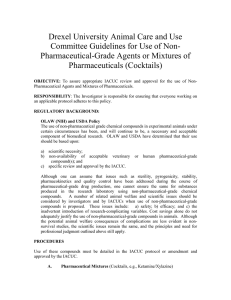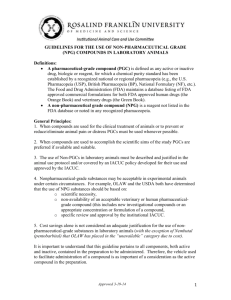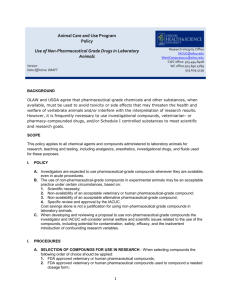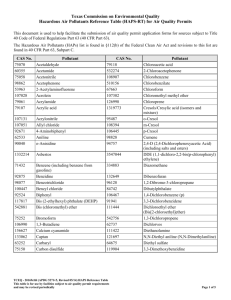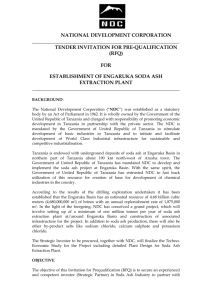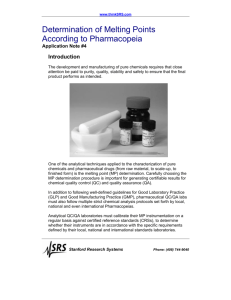Appendix F
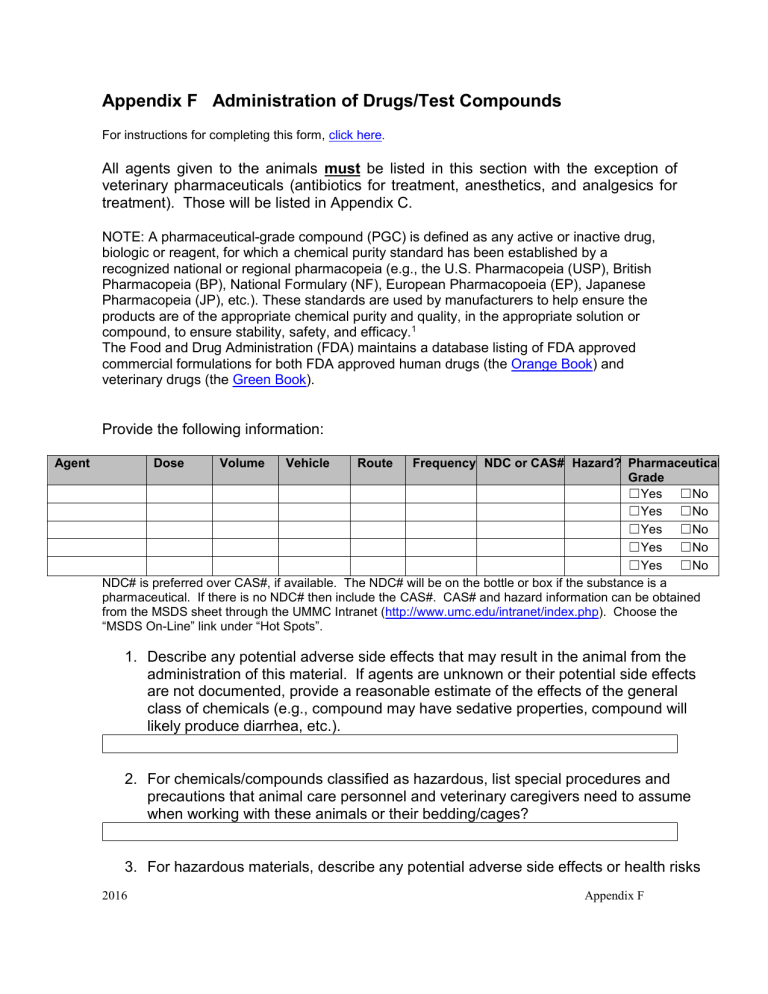
Agent
Appendix F Administration of Drugs/Test Compounds
For instructions for completing this form, click here .
All agents given to the animals must be listed in this section with the exception of veterinary pharmaceuticals (antibiotics for treatment, anesthetics, and analgesics for treatment). Those will be listed in Appendix C.
NOTE: A pharmaceutical-grade compound (PGC) is defined as any active or inactive drug, biologic or reagent, for which a chemical purity standard has been established by a recognized national or regional pharmacopeia (e.g., the U.S. Pharmacopeia (USP), British
Pharmacopeia (BP), National Formulary (NF), European Pharmacopoeia (EP), Japanese
Pharmacopeia (JP), etc.). These standards are used by manufacturers to help ensure the products are of the appropriate chemical purity and quality, in the appropriate solution or compound, to ensure stability, safety, and efficacy.
1
The Food and Drug Administration (FDA) maintains a database listing of FDA approved commercial formulations for both FDA approved human drugs (the Orange Book ) and veterinary drugs (the Green Book ).
Provide the following information:
Dose Volume Vehicle Route Frequency NDC or CAS# Hazard? Pharmaceutical
Grade
☐ Yes ☐ No
☐ Yes ☐ No
☐ Yes ☐ No
☐ Yes ☐ No
☐ Yes ☐ No
NDC# is preferred over CAS#, if available. The NDC# will be on the bottle or box if the substance is a pharmaceutical. If there is no NDC# then include the CAS#. CAS# and hazard information can be obtained from the MSDS sheet through the UMMC Intranet ( http://www.umc.edu/intranet/index.php
). Choose the
“MSDS On-Line” link under “Hot Spots”.
1. Describe any potential adverse side effects that may result in the animal from the administration of this material. If agents are unknown or their potential side effects are not documented, provide a reasonable estimate of the effects of the general class of chemicals (e.g., compound may have sedative properties, compound will likely produce diarrhea, etc.).
2. For chemicals/compounds classified as hazardous, list special procedures and precautions that animal care personnel and veterinary caregivers need to assume when working with these animals or their bedding/cages?
3. For hazardous materials, describe any potential adverse side effects or health risks
2016 Appendix F
to humans during preparation and administration.
4. For hazardous materials, describe decontamination procedures and means of disposal of contaminated animal carcasses and waste.
5. For hazardous materials, what is the time frame that animals and/or caging are considered hazardous?
6. For non-pharmaceutical-grade compounds: a. Justify the need to use the non-pharmaceutical-grade compound(s)
(e.g., veterinary or human pharmaceutical-grade product is not available). b. Discuss steps taken to ensure the health and welfare of the animals.
Examples may include grade, purity, sterility, pH, pyrogenicity, osmolality, stability, formulation, compatibility, storage, side effects, and pharmacokinetics of the compound(s).
Reference: UMMC Chemical Safety Manual http://ehs.umc.edu/documents/ChemicalSafetyPolicy2010.pdf
Please remember that the use of any hazardous material in animal rooms requires that a sign be posted in that room and on the cages containing the hazard in accordance with the policy on Signage for Hazardous Studies .
1 AAALAC Frequently asked questions about Non-Pharmaceutical Grade Compounds
2016 Appendix F
